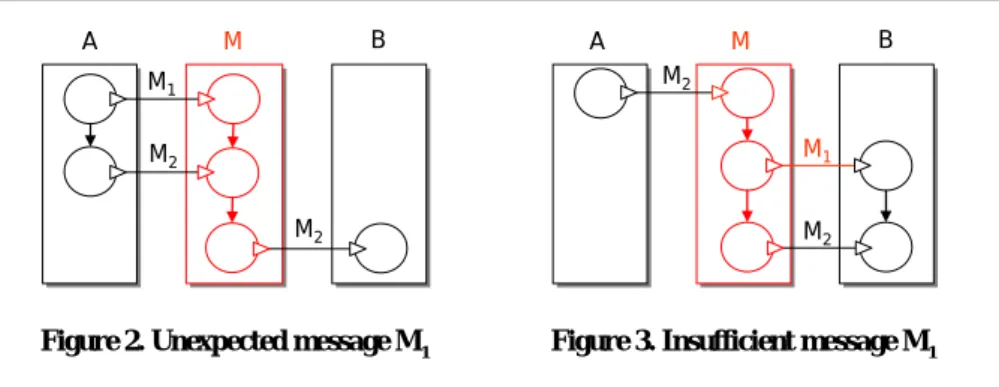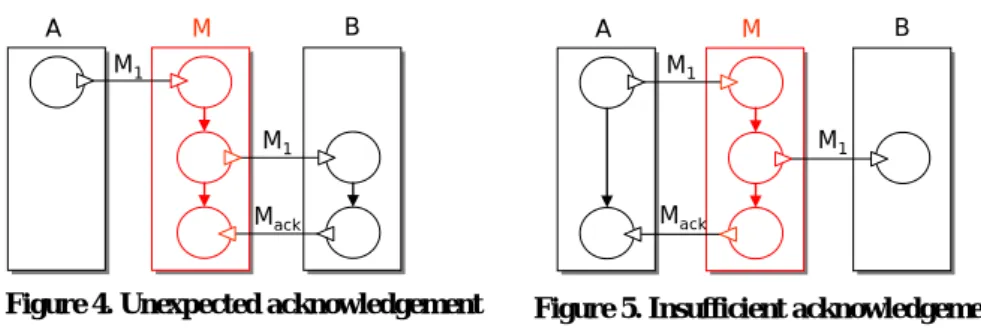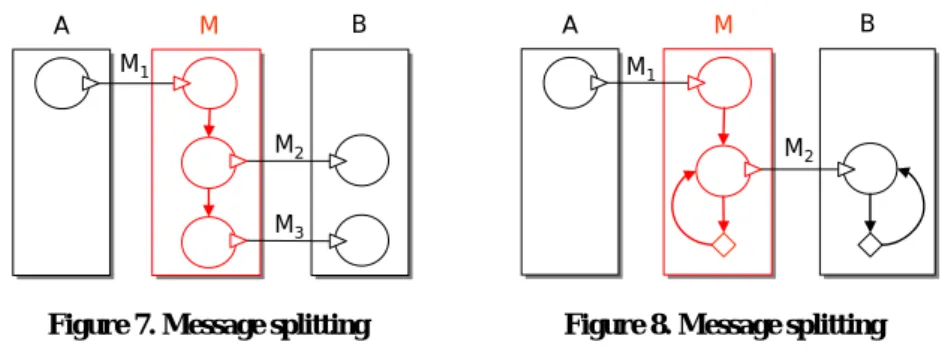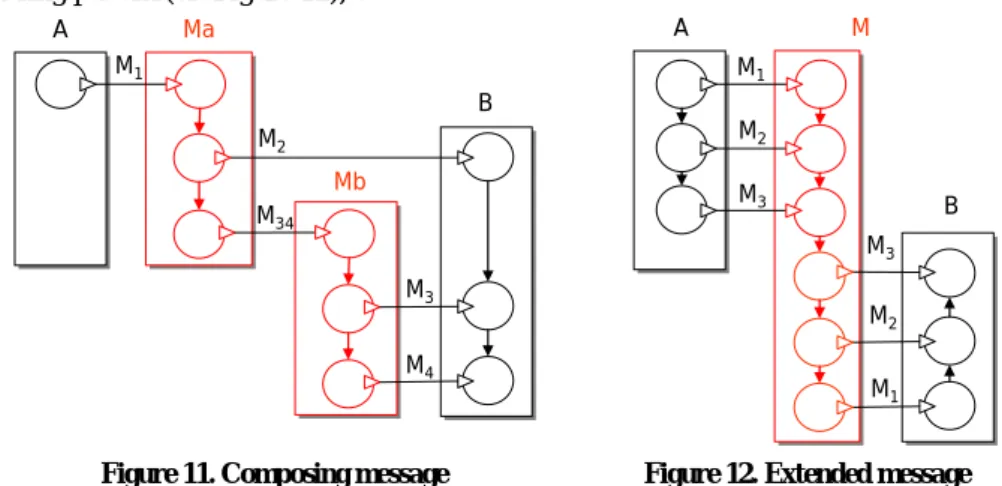Mediation Patterns for Message Exchange Protocols
Stanislav Pokraev1 and Manfred Reichert2
1 Telematica Instituut, P.O. Box 589, 7500 AN Enschede, The Netherlands Stanislav.Pokraev@telin.nl, http://www.telin.nl/
2 Center for Telematics and Information Technology,
University of Twente, P.O. Box 217, 7500 AE Enschede, The Netherlands M.U.Reichert@ewi.utwente.nl, http://www.ewi.utwente.nl/
Abstract. Systems interact with their environment (e.g., other systems) by ex- changing messages in a particular order. Interoperability problems arise when systems do not understand each other’s messages or follow incompatible mes- sage exchange protocols. In this paper we identify mismatches in message ex- change protocols (involving two systems) and we propose solution patterns to compensate these mismatches.
1 Introduction
In order to interoperate systems must follow compatible message exchange proto- cols. For example, if one system first sends message M1 and then message M2, the partner system should be able to receive these two messages in the same order (i.e., M1 before M2). However, autonomous systems (especially when built in isolation) do not always use compatible message exchange protocols and therefore cannot interop- erate. To compensate such mismatches and to make systems interoperable we need an additional system, which we denote as process mediator.
In this paper we identify the most common mismatches in message exchange pro- tocols and propose respective process mediators to compensate these mismatches.
Our findings are based on the result of a literature study [1][2][3][4] and a case study[5].
We illustrate the patters using the notation depicted in Figure 1.
System Message
sending Message
receiving Condition
Figure 1. Notation
2 Mediation Patterns
In the following we summarize typical mismatches in message exchange protocols and propose mediation patterns to compensate them.
Problem: System A intends to send two messages, first M1 and then M2, whereas system B expects only message M2.
Solution: Mediator M receives message M1 and ignores it. Next, it receives mes- sage M2 and forwards it to system B. This pattern is illustrated in Figure 2.
Problem: System B expects two messages, M1 and M2, whereas system A intends to send only message M2.
Solution: Mediator M receives message M2 from system A. Next, it uses addi- tional information (either provided by another system or derived from the execution history) to construct and send message M1 to system B. Finally, the mediator sends message M2 to system B. Note, that this mismatch can only be compensated if media- tor M has all information necessary to construct message M1. This pattern is illus- trated in Figure 3.
M1
M2
M2
M2
M1 M2
A M B A M B
Figure 2. Unexpected message M1 Figure 3. Insufficient message M1
Problem: System A sends message M1 to system B and continues without expect- ing an acknowledgement, whereas system B intends to send message Mack to ac- knowledge the reception of message M1.
Solution: Mediator M receives message M1 from system A, sends it to system B, and then receives the acknowledgement Mack on behalf of system A. This pattern is illustrated in Figure 4.
Problem: System A sends message M1 and expects acknowledgement Mack
whereas system B does not intend to send such an acknowledgement.
Solution: Mediator M receives message M1, sends it to system B, and then sends an acknowledgement (Mack) to system A on behalf of system B. This pattern is illus- trated in Figure 5.
M1
M1 Mack
A M B
Figure 4. Unexpected acknowledgement
M1
M1 Mack
A M B
Figure 5. Insufficient acknowledgement
Problem: System A intends to send message M1 first and then M2, whereas system B expects first message M2 and then M1.
Solution: Mediator M receives first message M1 and then message M2. Next, it sends message M2 first and then message M1. This pattern is illustrated in Figure 6.
M1
M2
M2
A M B
M1
Figure 6. Message reordering
Problem: System B expects two messages M2 and M3 whereas system A intends to send only one message M1 that contains both M2 and M3.
Solution: Mediator M first receives message M1. Then it uses the information from M1 to construct M2 and M3. Finally, the mediator sends M1 and M2 in the order expected by system B. This pattern is illustrated in Figure 7.
Problem: System B expects message M2 n times whereas system A intends to send only one message M1 that contains all n messages M2.
Solution: Mediator M first receives message M1. Then it starts a process of con- structing M2 from the information in M1 and sending M2 to system B. This process is repeated until some condition evaluates to true. The pattern is illustrated in Figure 8.
A M B
M2
A M B
Figure 7. Message splitting M3
Figure 8. Message splitting
M1 M1
M2
Problem: System A sends messages M1 and M2 whereas system B expects one message M3 that aggregates M1 and M2.
Solution: Mediator M receives both messages M1 and M2. Then it uses the infor- mation from these two messages to construct M3. Finally, the mediator sends M3 to system B. This pattern is illustrated in Figure 9.
Problem: System A sends message M1 n times whereas system B expects one sin- gle message M2 that aggregates all n messages M1.
Solution: Mediator M starts a process of receiving messages M1 until some condi- tion evaluates to true. Next, it uses the information in the received messages to con- struct M2 and then sends M2 to system B. This pattern is illustrated in Figure 10.
A M B
M1
A M B
M1 M2
Figure 9. Message combining
M3 M2
Figure 10. Message combining
3 Discussion
The presented mediation patterns address only mismatches in message exchange protocols. Some of the patterns (e.g., message splitting and aggregation) require se- mantic mapping between the data in the exchanged messages. Only if such mappings exist the mediators can construct an output message(s) provided input one(s).
More complex patterns can be constructed using the ones presented in the previous section. For example, splitting message M1 to three messages M2, M3 and M4 can be achieved by composing two ‘message splitting patterns’ (cf. Figure 11). Likewise,
changing the order of three messages can be achieved by extending the message reor- dering pattern (cf. Figure 12), etc.
Figure 11. Composing message splitting patterns
M1 M2
A M
M3 B M2
A Ma
B
M34 M1
M3 Mb
M4
M1
M2 M3
Figure 12. Extended message reordering pattern
4 Acknowledgments
The present work has been done in the Freeband Communication project A-Muse (http://a-muse.freeband.nl). Freeband Communication (http://www.freeband.nl) is sponsored by the Dutch government under contract BSIK 03025. The presented work a result of collaboration between the Telematica Instituut and the University of Twente, the Netherlands, which is partially supported by the Commission of the European Communities under the sixth framework programme (INTEROP Network of Excellence, Contract N° 508011, http://www.interop-noe.org/).
References
1. Bussler, C. B2B-Integration: Concepts and Architecture. Springer-Verlag, 2003.
2. Cimpian, E. and Mocan, A. Process Mediation in WSMX. WSMX Working Draft, 08 July 2005. http://www.wsmo.org/TR/d13/d13.7/v0.1/
3. Hohpe, G. and Woolf, B. Enterprise Integration Patterns: Designing, Building, and Deploying Messaging Solutions. Addison-Wesley Professional, 2004.
4. Pollock, J. T. and Hodgson, R. Adaptive Information: Improving Business Through Semantic Interoperability, Grid Computing, and Enterprise Integration.
Wiley-Interscience, 2004.
5. Semantic Web Services Challenge 2006, http://sws-challenge.org



